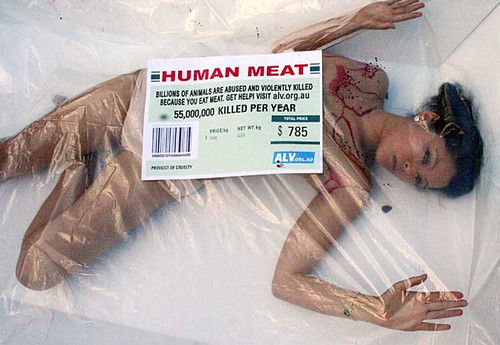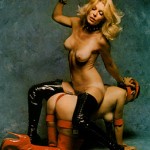A post on Vegan Times got me thinking about the use of the naked human body. “An Open Letter to PeTA” makes a feminist critique PETA’s use of sexualized imagery in its ads against animal cruelty:
Like animal exploitation, which turns non-human individuals into objects of consumption for humans, patriarchy as a cross-cultural and trans-historical phenomenon has always involved the ‘thingification’ of women’s bodies, manifested either through outright ownership (by husbands and fathers), or through widespread sexual objectification. Both non-human slavery and patriarchy are heavily steeped in the fetishization of violence. It would seem, then, that an organization ostensibly committed to the eradication of animal exploitation would also support the eradication of gender hierarchy. Yet judging from your track record, this has not been the case.
The post continues to discuss one of PETA’s ads.
In the ad pictured above, an ‘animalized’ woman is being hunted down by men who will dominate her. Having power – the power of force – over her, they have captured her and are now seen to own her, ready to use her for what she is, because she is hunted meat. They are hunters, powerful and self-possessed; she is a thing – an object – of nature, to be used and ravished by them. The chains on her body and the weapons wielded by the men suggest violence and domination. The thrill is in the chase, the over-powering; the pleasure is to be found precisely in the non-consensual nature of the act. The hierarchies alluded to in this picture (man over woman, human over non-human) are both believable and easy to take for granted at first sight because they accurately mirror the objective realities of our world as it currently stands. It is not altogether clear, however, how glamourizing this is supposed to educate or enlighten those who take such power relationships for granted as being in the ‘natural’ order of things. It is similarly unclear what the average viewer is supposed to have learned about cruelty towards elephants from this sexist advertising, or indeed, how such advertising inspires anyone to act in any meaningful way. But why worry about something as trivial as helping animals when you can create empty media hype, instead?
(There are also some uncomfortable racial and colonial issues in that image.)
In some cases, PETA media depicts people not as living animals, but as processed and packaged food products, an even deeper degree of depersonalization.
Compare the PETA ads to some of the porn images from the cannibalism niche fetish site Muki’s Kitchen:

Note that Muki’s Kitchen depicts a very sanitized version of the cannibalism fetish, without blood, gore or dismemberment of the people. There’s an interesting parallel to the “food porn” photography seen in cookbooks and food magazines, in which the food is presented as a beautiful finished product, and the mess and labour of preparation is only hinted at, and the work of slaughtering meat animals is not shown at all.
I recently stumbled across a bit of Internet folklore known as Poe’s law:
“Without a winking smiley or other blatant display of humor, it is impossible to create a parody of fundamentalism that someone won’t mistake for the real thing.”
This suggests that at some point PETA imagery and Muki’s Kitchen imagery intersect.
Setting aside the question of how effective this is kind of advertising is in accomplishing its stated goal, how does this strange convergence of imagery happen? Why is PETA bent on making its point with pornography? Is it solely to gather attention?
The Vegan Times website identifies itself as an “online, abolitionist vegan journal”, which explicitly links it to the 19th century movement for the abolition of slavery. It is instructive to compare the uses of media, and particularly visual representations, by the two movements. Marcus Wood’s Blind Memory shows just how difficult it is to think about the suffering of others, and how media intended to create sympathy instead becomes fodder for masochistic fantasy. There is a lineage from slave narratives to sadomasochistic pornography, though the path is neither short nor straight. William Blake, in his abolitionist engravings, attempted to humanize black slaves in the eyes of white viewers, and ended up drawing comely, dark-skinned figures who suffered beautifully under the lash.
PETA is repeating that same pattern, centuries later. They don’t even wait for another group to parody their own efforts. They do it themselves.
PETA repeatedly shows people as animals or objects, and also animals as people. In a strange way, the effort to humanize animals may have resulted in the view of animals as, not dumb, non-sentient beasts, but liminal beings who have emotions but not intellects. The animal becomes role a person can move into for a time and experience a different identity, relief from the demands of sentience.






